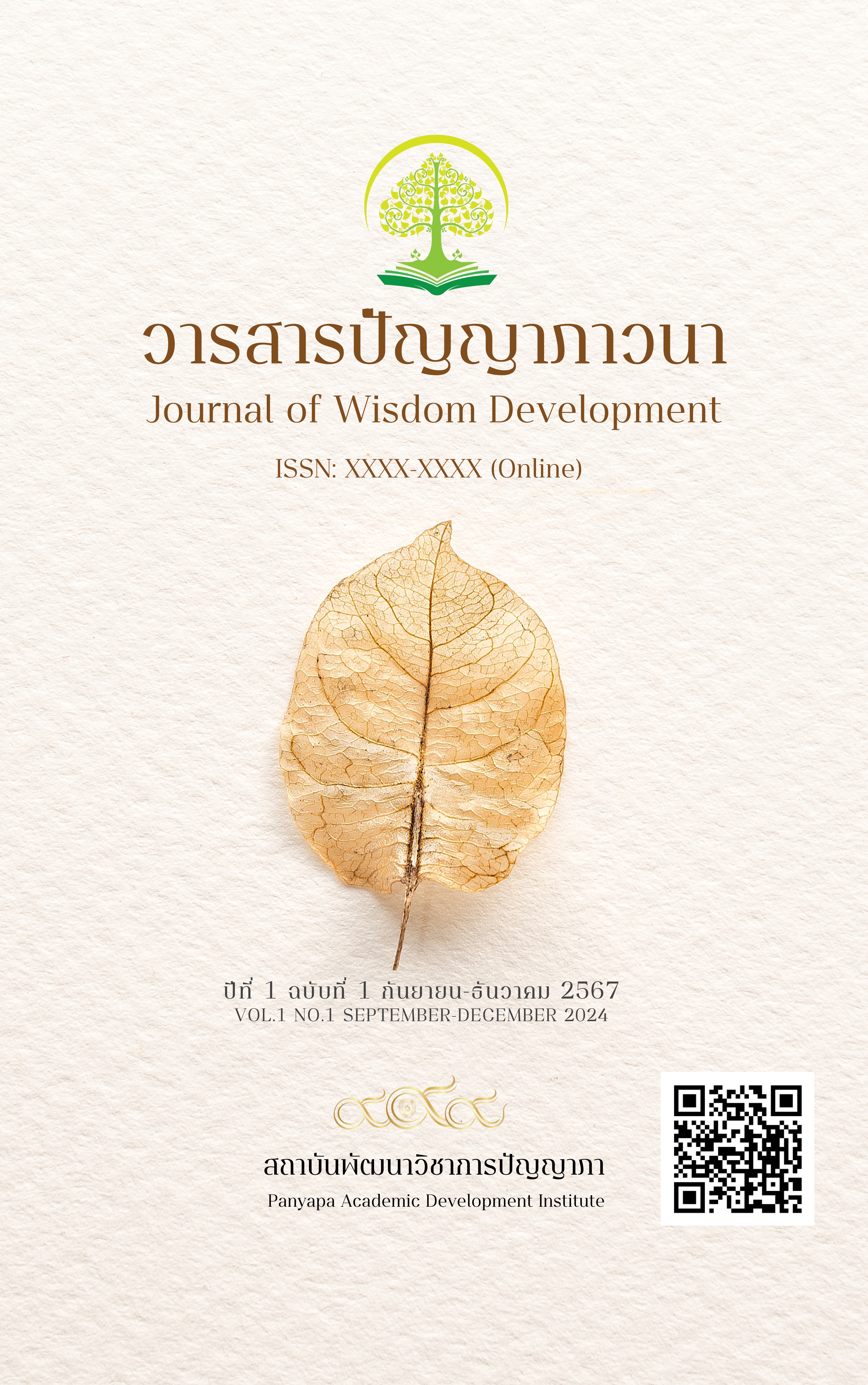Developing Creative Thinking Processes in Integrated Teaching and Learning for Modern Students Using the NUKIDS
Keywords:
Creative Thinking, Integrated Teaching, NUKIDS ConceptAbstract
This article discusses the NUKIDS concept, an instructional framework emphasizing the development of essential skills for students in the 21st century. The concept comprises several core components aimed at preparing students to face the challenges of a rapidly changing world. These components include the development of new skills such as communication, critical thinking, and collaboration, which are crucial for effective teamwork. Deep understanding of content (Understanding) and knowledge integration (Knowledge Integration) across multiple disciplines enable students to connect diverse knowledge and apply it in real-world situations. Additionally, the NUKIDS concept promotes creative thinking (Innovation), allowing students to innovate and create new, valuable contributions. Digital literacy is another essential component, given the significant role of technology in current learning and work environments. Utilizing digital tools for research and creative work helps students develop skills necessary for effective living in the digital world. Finally, the NUKIDS concept emphasizes sustainability (Sustainability) by encouraging students to consider the impact of their actions on the environment and society. Learning about sustainability prepares students to be responsible citizens engaged in building a sustainable world. To enhance the effectiveness of the NUKIDS concept in the future, it is essential to train and develop teachers to have an understanding and skills in integrated teaching. Supporting diverse and modern educational resources and teaching materials is also crucial for improving the effectiveness of NUKIDS-based teaching. Furthermore, the application of this concept in contexts beyond school education, such as in employee training in organizations or commnity skill development, should be considered to foster skills essential for sustainable growth and addressing future challenges. Integrating the NUKIDS concept into various contexts will help create a dynamic society capable of adapting to change effectively.
References
ทวีศักดิ์ จินดานุรักษ์. (2559). การพัฒนาและประเมินความคิดสร้างสรรค์ในสถานศึกษา. วารสารศึกษาศาสตร์, 27(1), 1-14.
ธนกร คงรัตน์. (2560). ปัจจัยด้านการจัดการไอเดียความคิดสร้างสรรค์ และสมรรถนะของบุคลากรที่ส่งผลให้เกิดนวัตกรรมในองค์กร กรณีศึกษา บริษัทผู้ผลิตยางรถยนต์ขนาดใหญ่ในประเทศไทย. วิทยาศาสตร์มหาบัณฑิต มหาวิทยาลัยธรรมศาสตร์
บวร เครือรัตน์. (2562). การพัฒนารูปแบบการจัดการเรียนการสอนเน้นความคิดสร้างสรรค์สาหรับ นักศึกษาปริญญาตรีวิชาความคิดสร้างสรรค์เพื่อการออกแบบ. Veridian E-Journal, Silpakorn University, 12(3), 476-494.
เบญจวรรณ ถนอมชยธวัช, ผ่องศรี วาณิชย์ศุภวงศ์, วุฒิชัย เนียมเทศ, ณัฐวิทย์ พจนตันติ. (2559). ทักษะแห่งศตวรรษที่ 21: ความท้าทายในการพัฒนานักศึกษา 21st Century Skills: A Challenge for Student Development. วารสารเครือข่ายวิทยาลัยพยาบาลและการสาธารณสุขภาคใต้, 3(2), 208-222.
ประจักษ์ ปฏิทัศน์ (2562) การคิดเชิงระบบและความคิดสร้างสรรค์ (SYSTEMATIC AND CREATIVE THINKING). กรุงเทพฯ : จุฬาลงกรณ์มหาวิทยาลัย.
พระมหาประยุทธ์ ปยุตฺโต (ยาวิชัย). (2564). การจัดการเรียนการสอนแบบบูรณาการในชั้นเรียน. Journal of Roi Kaensarn Academi, 6(12), 329-342.
ไพฑูรย์ สินลารัตน์ และคณะ. (2559). การศึกษา 4.0 เป็นยิ่งกว่าการศึกษา. กรุงเทพฯ: โรงพิมพ์แห่ง จุฬาลงกรณ์มหาวิทยาลัย.
มณฑล สรไกรกิติกูล. (2562). สถานการณ์ท้าทายที่กระตุ้นการสร้างความรู้ ของพนักงานในองค์กรขนาดใหญ่. Journal of Intelligence, 14(1), 28-44.
มารุต พัฒผล. (2562). รูปแบบการพัฒนาหลักสูตรร่วมสมัย. กรุงเทพฯ: ศูนย์นวัตกรรมหลักสูตรหลักสูตรและการเรียนรู้.
ศิวกร อโนรีย์. (2564). ปัจจัยที่มีผลต่อความได้เปรียบทางการแข่งขัน และความสำเร็จของผู้ประกอบการ วิสาหกิจขนาดกลางและขนาดย่อมในเขตจังหวัดราชบุรี. (วิทยานิพนธ์บริหารธุรกิจมหาบัณฑิต). มหาวิทยาลัยศิลปากร.
ศิวลาภ สุขไพบูลย์วัฒน์. (2560). บทบาทของผู้สูงอายุต่อความเจริญเติบโตทางเศรษฐกิจในประเทศไทย. วารสารศรีนครินทรวิโรฒวิจัยและพัฒนา, 9(11), 176-191.
สิทธิพล อาจอินทร์. (2561). การพัฒนาหลักสูตร. ขอนแก่น: โรงพิมพ์มหาวิทยาลัยขอนแก่น.
สุภารัตน์ จูตระกูล. (2559). ครอบครัวกับการรู้เท่าทันสื่อดิจิทัล (Digital Literacy) ของดิจิทัลเนทีฟ (Digital Natives). วารสารวิทยาการจัดการ มหาวิทยาลัยราชภัฏเชียงราย, 11(1), 131-150.
เหงียน ถิทูฮ่า และสิรินาถ จงกลกลาง. (2561). การศึกษาทักษะการเรียนรู้ในศตวรรษที่ 21 ของนักเรียนมัธยมศึกษาตอนปลายจังหวัดกาวบั่ง ประเทศเวียดนาม. วารสารวิจัย มหาวิทยาลัยขอนแก่น, 2, 14-18.
เอกชัย อ้ายม่าน และคณะ. (2565). ศึกษานิเทศก์ยุคใหม่ : การปรับตัวต่อความท้าทายในโลกที่เปลี่ยนแปลง. วารสารการบริหารการศึกษาและภาวะผู้นำมหาวิทยาลัยราชภัฏสกลนคร, 10(39), 1-8.
Beane, J. (1997). The Middle School : The Natural Home of integrated. Curriculum, Educational Leadership, 49(2), 9 – 13.






